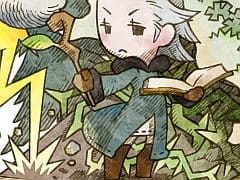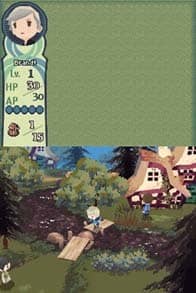You can trust VideoGamer. Our team of gaming experts spend hours testing and reviewing the latest games, to ensure you're reading the most comprehensive guide possible. Rest assured, all imagery and advice is unique and original. Check out how we test and review games here
Final Fantasy: Four Heroes of Light is an eight-week old kitten. It’s got huge green eyes, a little pink nose and ears that twitch when it sleeps; the very definition of cute. Yet if you were to try and scoop it up for a cuddle, it’d scratch your eyes out with knife-like claws. Only the most experienced of cat owners can tame the tiny beast, which will tear your skin to shreds unless you know exactly how to treat it, and Four Heroes of Light should be handled with the same care. It makes use of gorgeous pop-up book visuals, cel-shaded with faint water-coloured hues, to look as if it was designed for a six year-old girl. The RPG mechanics underneath, however, are ball-bustingly hard. Six year old girls are going to get their asses kicked.
The first half an hour of the game lets players know from the off there will be absolutely no hand-holding here. After accepting a quest to save a princess (the game revels in its role playing clichés) the young Brandt (although you can name him whatever you want) is thrown out into the world with nothing more than a basic sword and a potion. You have no allies, no spells and no option to run away. You’ll die a lot. Thankfully, each time you do you’ll be returned to the nearest town, with all your hard earned experience points left intact. You might lose a few gems – precious rocks that can be swapped for even more precious Gil – but you’ll be ready to fight another day.
After dying three or four times, you’ll make it far enough through the first dungeon (a cave, surprise surprise) to meet Jusqua, one of the other four heroes of light. Jusqua is a bit of a Billy-badass; rude and arrogant in equal quantities, but he sure knows how to swing a blade. This is fortuitous, because the first battle with him in tow is against a hulking great big Minotaur. The combat system is traditional in the best possible sense of the word; turn-based, with a simple interface and all the time in the world to make your decisions – none of that new-fangled ATB malarky. Instead of using MP, however, the game makes use of a five point ability system. Casting a fire spell, for example, expends two ability points, but these can be replenished at any stage by sacrificing a turn to ‘boost’. This might not be an immediately enticing option, but doing so will also increase your defence. Boosting quickly becomes a staple of combat, and is absolutely vital in downing tougher enemies.
After saving Princess Aire, who just so happens to be another of the four heroes of light, the crown system becomes available. Essentially evolutions of the age-old job system, crowns allow the player to change the class of their character on the fly by changing the item on their head. The first crown you come across is known as the Wayfarers hat, which boosts all attributes by a point as well as offering the ability to escape – an incredibly important skill early on in the game, I can tell you. Later on you’ll come across black mages crowns, white mages crowns, crowns for warriors and crowns for thieves. Each crown is reflected in your character’s in game appearance, too, as well as any other robes, shields or suits of armour you might happen upon.
Between the first main quest and the second, you’ll find yourself grinding a lot in order to be on equal footing with new enemies. It subsequently takes time to get anywhere in the game, made worse by an infuriating lack of pointers and directions. Often you’ll have no idea what to do, or where to go, and will end up aimlessly roaming about until you happen to stumble on something by accident. That said, I grew to quite like the exploration this forced. It might not sit well with those looking to plough straight through the story, but for anybody looking to lose themselves in the quaint world of the game it’s a blessing in disguise.
The story doesn’t take itself too seriously, quickly introducing new plot lines and rarely interrupting play with cutscenes. It presents a problem – a village turned to stone, a child kidnapped by pirates – and simply asks that you do the heroic thing and sort it out. There’s an overarching narrative concerning a crystal to tie everything together, but this is left on the backburner for most of the game. The characters aren’t developed to any crazy depths, but each has a distinct personality: Princess Aire is arrogant and obnoxious, spoilt by royalty; Yunita is patient and loyal, the perfect guardian for Aire; Jusqua couldn’t give a crap about anything; and Brandt is your quintessential justice-obsessed adventurer. The foursome split up fairly early on, too, allowing the introduction of several new characters that join the adventure for a short while.
Four Heroes of Light also makes use of WiFi connectivity, allowing players to jump into the world of a friend for some co-operative adventuring. It’s a nice bonus for those socially inclined, and works well in the context of four heroes – but I always find these multiplayer features go largely to waste. But that’s probably just me.
Four Heroes of Light is a refreshing departure for the franchise, ditching pretty much every convention the series has established over the years. Chocobos, Moogles and Airships are nowhere to be found here, and if it wasn’t for the words ‘Final’ and ‘Fantasy’ in the title, you might not have guessed it was part of the same series. This might disgruntle some Final Fantasy fans, but as a standalone experience this is an RPG that can hold its head high. Four Heroes of Light is very much its own thing; quaint and deceptively difficult – a combination that fans of the genre should grab hold of with both hands.

/https://oimg.videogamer.com/images/6789/ff_the_4_heroes_of_light_3.jpg)






